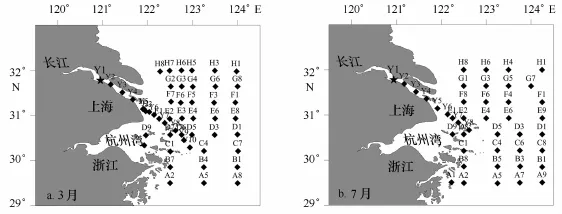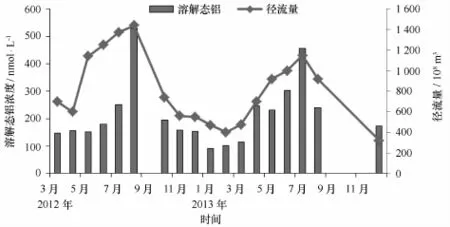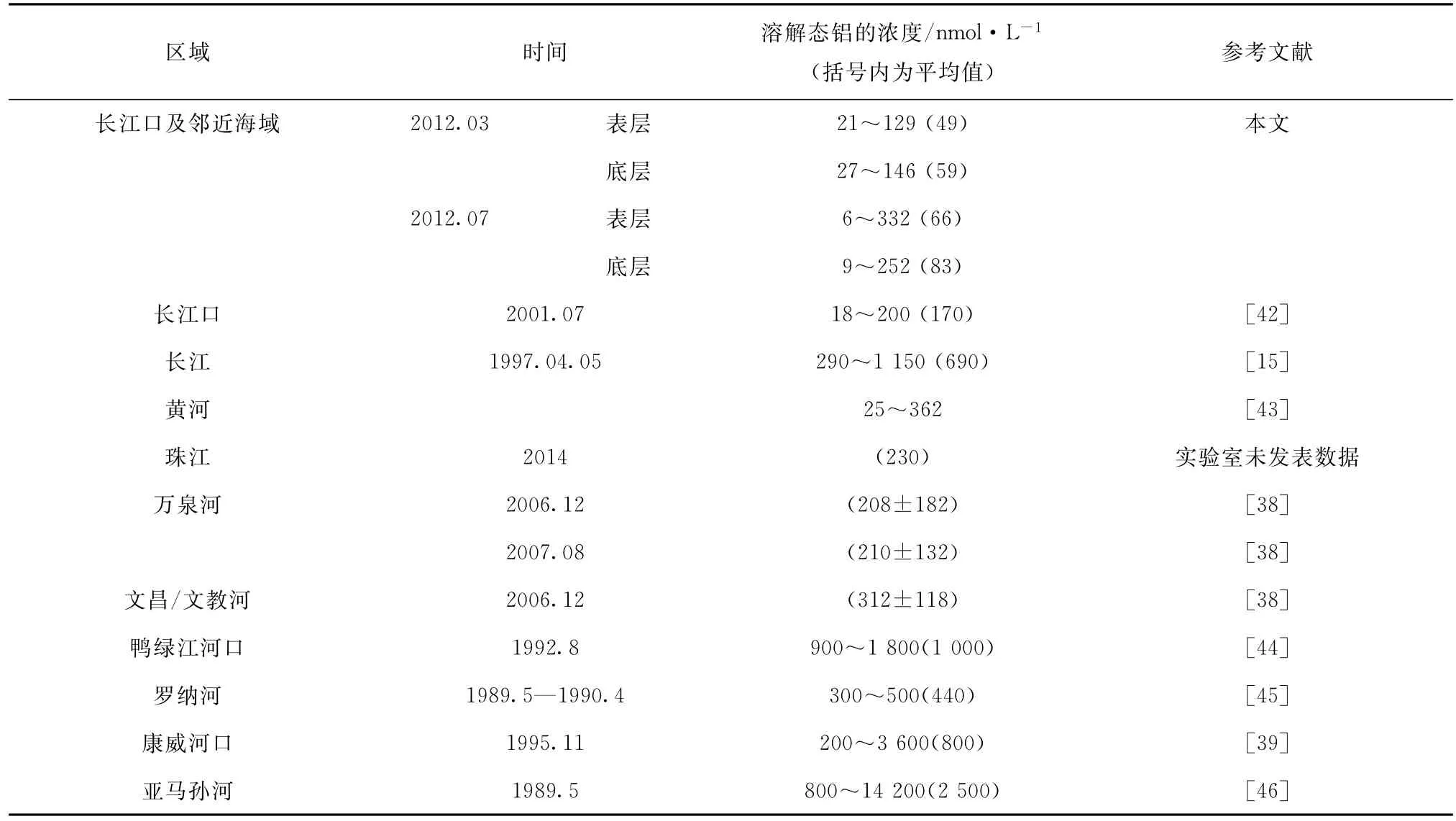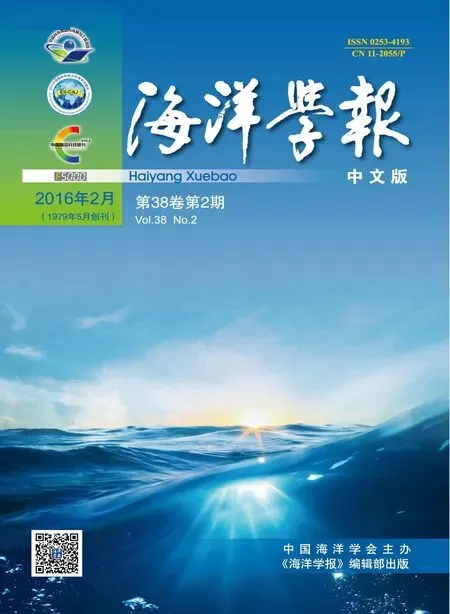长江口及其邻近海域2012年3月和7月溶解态铝的分布特征分析
郭颖,任景玲*,李发明,王召伟,张许州,张瑞峰
(1.中国海洋大学海洋化学理论与工程技术教育部重点实验室,山东青岛266100;2.华东师范大学河口海岸学国家重点实验室,上海200062)
长江口及其邻近海域2012年3月和7月溶解态铝的分布特征分析
郭颖1,任景玲1*,李发明1,王召伟1,张许州1,张瑞峰2
(1.中国海洋大学海洋化学理论与工程技术教育部重点实验室,山东青岛266100;2.华东师范大学河口海岸学国家重点实验室,上海200062)
分别于2012年3月和7月对长江口及其邻近海域水体中溶解态铝的分布及其影响因素进行了研究,并在2012年3月至2013年11月期间对长江徐六泾进行了连续观测。结果表明,徐六泾溶解态铝在夏季出现最高值,在冬季呈现最低值,平均值分别为(313±130)nmol/L和(140±43)nmol/L,表现出与径流量相似的季节变化规律。受陆源输入变化的影响,长江口溶解态铝的浓度由近岸向外海逐渐降低,且呈现出明显的季节性差异,即7月明显高于3月。3月表、底层海水中溶解态铝的浓度范围分别为21~129 nmol/L和27~146 nmol/L,平均值分别为(49±21)nmol/L和(59±27)nmol/L;7月表、底层溶解态铝的浓度范围分别为6~332 nmol/L和9~252 nmol/L,平均值分别为(66±69)nmol/L和(83±74)nmol/L。在7月,表、底层溶解态铝呈现显著性差异,底层沉积物的再悬浮可能是造成差异的主要原因。调查结果表明,溶解态铝在长江口呈现出清除型行为,清除主要发生在咸淡水混合初期,初步计算出7月份溶解态铝的清除率约为55%。
溶解态铝;分布;季节变化;清除百分数;长江口
1 引言
铝是岩石中含量最高的金属元素,约占地壳总量的8.0%[1—2],主要以铝硅酸盐的形式存在于岩石和矿物中。但因铝硅酸盐在风化过程中的溶出率低且在天然水体中存留时间较短等原因,导致天然水体中溶解态铝的浓度很低,属于痕量元素。海洋中铝的海洋生物地球化学行为一直受到广泛关注,是国际海洋研究计划GEOTRACES规定的关键参数之一。海洋中铝的主要来源有大气沉降[3—6]、河流输入[7—8]和底层沉积物再悬浮过程的释放[8]等;由于自身的高颗粒活性,铝极易吸附在颗粒物表面而被清除出水体,因此颗粒物表面的吸附清除是其主要的汇[10—12]。目前已有结果表明,在水华后溶解态铝浓度发生明显的降低,说明浮游植物水华能有效地清除水体中的铝,但其清除机理尚未明晰。近岸海域溶解态铝则主要来源于河流输送[8—9,13],而河流中的溶解态铝主要来源于流域的岩石风化产物,常以其浓度指征陆源物质输送。
长江是亚洲第一大河,每年流入东海的径流量达9 320亿立方米,占入东海全部河流的79.7%,输沙量每年高达46 144万吨,占入东海全部河流的73.1%[13—14]。近年来,已有诸多有关长江口邻近海域溶解态铝分布及影响因素的报道:Ren等构建了长江口邻近海域溶解态铝的三端元混合模型,并以此估算长江冲淡水对PN断面的影响[15];闫丽等报道了长江口及其邻近海域溶解态铝的浓度分布及其季节变化[16];李发明等利用二端元混合模型讨论了水团混合对长江口邻近海域溶解态铝分布的影响,并利用闽浙沿岸多发赤潮的特点初步研究了浮游植物水华对溶解态铝的清除作用[17]。但是以上研究主要集中于盐度高于25的外河口及邻近海域,而对于长江口门内及口门附近低盐区(盐度小于20)溶解态铝的分布及其生物地球化学过程仍然缺乏深入的了解。本文通过对长江(徐六泾)20个月的连续观测,借此研究溶解态铝长江径流量的月际变化规律,并以长江口门内溶解态铝的浓度探究溶解态铝在长江口的行为变化过程,定量估算了溶解态铝在河口的清除比例。同时讨论了2012年3、7月份长江口邻近海域溶解态铝的分布规律、季节变化及影响因素,研究结果对于深入认识河流-河口-近海系统中溶解态铝的生物地球化学行为具有重要意义。
2 采样与方法
2.1样品采集和预处理
分别于2012年3月6-14日、7月14-18日参加了国家自然科学基金委长江口海域公共航次观测,分别搭乘“海监46”和“海监47”科学调查船对长江口及其邻近海域进行了大面调查,调查区域位于29°~32°N,120°~124°E;于2012年3月至2013年11月期间,在徐六泾断面采集水样,研究长江溶解态铝的季节变化。具体采样站位如图1所示。

图1 2012年3月(a)和7月(b)长江口及邻近海域采样站(Y1为徐六泾)Fig.1 The sampling position figure of the Changjiang estuary and its adjacent marine Area in March(a)and July(b),2012(Y1 is Xuliujing)
长江口口门内的表层海水样品使用“飞鱼”采样系统采集,其他海水样品用5 L Niskin采水器采集。采水器使用前用酒精擦去颗粒物,并用Milli-Q水冲洗干净,采样瓶和样品瓶在使用前均用1∶5盐酸浸泡1周左右,取出后先后用蒸馏水和Milli-Q水冲洗干净,装入双层塑料袋中。在简易洁净工作台中,用处理过的Nalgene滤器和0.45μm醋酸纤维滤膜(经p H=2的HCl浸泡,Milli-Q水洗至中性)过滤样品,将过滤后的水样装入低密度聚乙烯瓶中,冷冻(-20℃)保存。空白为同样条件下过滤的Milli-Q水,用相同方法保存。
2.2样品测定
溶解态铝的测定方法采用改进的LMG(荧光镓)分子荧光[18]分析方法,检测限为0.25 nmol/L,精密度在40 nmol/L和1 nmol/L时分别为5%和6.7%,测样时采用标准加入法来克服基质干扰。悬浮颗粒物(SPM)含量用过滤前后烘干恒重滤膜的质量差值计算。
3 结果与讨论
3.1长江口及其邻近海域溶解铝的分布及年际和季节性变化
图2为2012年3月至2013年11月对徐六泾进行连续观测的结果。根据徐六泾溶解态铝月际变化结果,溶解态铝与径流量的季节变化规律相同,在夏季出现最高值而冬季出现最低值,这主要是由于夏季长江径流量增大,陆源物质输送也随之增加所导致。通过河流排放出的陆源物质会对近海区域造成一定影响,表1给出了2012年3月和7月长江口及其邻近海域调查期间的温度、盐度、SPM含量以及溶解态铝浓度的含量范围及其平均值。由表可见,3月表、底层温度、盐度均呈现出显著性差异(t检验,p<0.05,n=35),底层温度低于表层而底层盐度明显高于表层,但溶解态铝在表、底层未表现出显著性差异(t检验,p<0.05,n=35);7月表、底层温度并未表现出显著性差异(t检验,p<0.05,n=24),而盐度及溶解态铝在表、底层表现出显著性差异(t检验,p< 0.05,n=24),均呈现底层高于表层的特点。
表2给出了在2002-2003、2006、2007-2008年间开展的有关长江口邻近海域溶解态铝的调查结果与本次调查结果的对比,共计10个航次[16—17,19]。结果表明,溶解态铝季节性变化显著,全年最高值出现在夏季,最低值常出现春、冬季,其浓度基本与长江径流量呈正相关;而溶解态铝年际变化较小。夏季易暴发浮游植物水华,2002年8月发生浮游植物水华时期,溶解态铝的浓度最小值仅为6 nmol/L。以上航次结果对研究长江口及其邻近海域2012年3月和7月溶解态铝的分布特征提供了基础。

图2 2012年3月至2013年11月徐六泾溶解态铝浓度和径流量的变化Fig.2 The variation about runoff and the concentration of dissolved aluminum at Xuliujing from March 2012 to November 2013

表1 2012年3月和7月长江口及邻近海域温度、盐度、SPM含量及溶解态铝的浓度(括号内为平均值)Tab.1 The temperature,salinity,SPM and the concentration of dissolved aluminum in the Changjiang Estuary and its adjacent marine area in March and July 2012(averages are shown in brackets)
2012年3月和7月长江口及其邻近海域表、底层海水温度、盐度和溶解态铝浓度的水平分布如图3和图4所示。3月份表层盐度呈现向东南方向升高的趋势,底层则有一高温高盐水舌自南向北伸展至近32°N;7月份表层盐度整体呈现向长江口东北方向升高的趋势,在口门北部有一高温低盐水团,底层有一向北延伸的低温高盐水舌直至31.5°N,未达到3月底层高温高盐水舌入侵位置。以30等盐度线作为长江冲淡水影响的边界[20—22]可以发现,春季长江冲淡水向东扩展至123°E,而7月长江冲淡水比3月向东扩展得更远(达到124°E),几乎覆盖了整个调查区域的表层。悬浮颗粒物的分布由近岸向远岸方向迅速降低,最高浓度出现在杭州湾口处,位于长江口偏南方向,这与先前研究结果相一致,虽然长江冲淡水的偏转方向存在季节性差异,但是其输送的泥沙均大量沉积在长江口偏南方向[23]。

表2 长江口及其邻近海域溶解态铝及长江径流量的年际变化(括号内为平均值)Tab.2 Annual variations of dissolved aluminum concentration in the Changjiang Estuary and its adjacent area and the runoff of Changjiang(average are shown in brackets)
溶解态铝浓度在长江口、杭州湾口最高,整体分布趋势呈现由近岸向远岸方向降低的特点。长江出海口分为南支和北支,3月表层在32°N,122.5°E附近出现溶解态铝的高值,可能是陆源物质从北支出海口输送所导致;底层溶解态铝高值出现在近杭州湾处。7月表层,长江口北部被一高温低盐水团占据,对应溶解态铝的高值区域,两者呈现明显的负相关性。这与盐度30等值线偏移方向一致,长江冲淡水受径流量和季风作用在不同季节偏转方向不同[24],2012年7月径流量高于多年平均值[25],在夏季盛行的南季风影响下,发生东北方向的偏移[26],因此,这一高值区域是由长江冲淡水带来的。而在底层,高值区域出现在长江口南部和杭州湾口区域,对应该区域的悬浮颗粒物浓度较高,容易发生底沉积物的再悬浮,从而导致溶解态铝浓度有所增加。除此之外,7月可以明显地看到沿着长江冲淡水偏转方向(长江口东北区域)随着离岸距离的增加,溶解态铝浓度迅速降低(小于10 nmol/L),明显低于春季的最低值(21 nmol/L),通过卫星遥感图片(http://oceancolor.gsfc.nasa.gov/cgi/l3?ctg=Standard&sen=A&prd=CHL_chlor_ a&per=MO&date=1Feb2010&res=9km&num= 24)及采样航次报告可知,2012年7月长江口邻近海域有水华发生,根据以往现场及实验室培养结果来看,浮游植物对溶解态铝有清除作用[10,12,27—30],也有研究证明硅藻能够吸收铝生成硅藻细胞壳,从而被清除出水体[30]。
3.2悬浮颗粒物对底层溶解态铝分布的影响
7月底层溶解态铝整体高于表层,与SPM的表、底层分布相似。铝属于颗粒活性元素,颗粒物-水体界面之间的交换过程对溶解态铝的分布起着重要的作用[9,11],已有研究表明,SPM对溶解态铝的影响是一个吸附解吸的动态平衡过程。正如图5a表现出在一定范围内,铝的浓度随颗粒物的增加而升高,当颗粒物的浓度增加到一定的程度时,铝的浓度趋于平稳,与任景玲等[15]和Li等[34]的观察结果相似。而在两个月份表、底层盐度有显著性差异的前提下,只有在7月份发现调查区域内表、底层溶解态铝出现显著性差异,7月是长江输沙量径流量充沛期,悬浮颗粒物对溶解态铝的影响比3月更为显著,如图5b所示,底层溶解态铝随着SPM的增加而增加,底层沉积物再悬浮是底层溶解态铝的一个源,而在3月份并未观察到类似情形。

图3 2012年3月长江口及邻近海域表、底层海水中温度(℃)、盐度、SPM含量(mg/L)及溶解态铝浓度(nmol/L)的分布Fig.3 The distributions of temperature,salinity,SPM and the concentration of dissolved aluminum in the Changjiang Estuary and its adjacent marine area in March 2012
3.3溶解态铝在长江口的行为
2012年3月和7月航次中均利用“飞鱼”采水器采集长江口内低盐度水样。如图6所示,以盐度为0的站位为分界点,在口门内,横坐标以距盐度为0站位的距离表示,而出长江口后则以盐度表示。从图6可以看出,3月与7月口门内盐度为0的站位位置有所不同,7月份口门内低盐度站位多于3月,主要与潮位变化有关。在3、7月均发现在低盐度时,随着盐度的增加溶解态铝显著降低,而后随着盐度增加,溶解态铝浓度变化不大。

图4 2012年7月长江口及邻近海域表、底层海水中温度(℃)、盐度、SPM含量(mg/L)及溶解态铝浓度(nmol/L)的分布Fig.4 The distributions of temperature,salinity,SPM and the concentration of dissolved aluminum in the Changjiang Estuary and its adjacent marine area in July 2012

图5 2012年7月溶解态铝浓度与SPM含量之间的关系Fig.5 The relationship between the concentration of dissolved aluminum and SPM a.所有层次的数据点,b.底层的数据点All layers of data points were shown in figure a,only the bottom of the data points were shown in figure b
长江口最大浑浊带位置与盐水楔、滞流点、浮泥的活动范围非常吻合,泥沙输移、水动力和生物地球化学过程十分复杂[35],在河口盐水和淡水混合处,溶解态金属可能由于生物地球化学和沉积等过程而迁移,表现出非保守型行为[36]。已有学者研究了多种溶解态金属在长江河口的分布和行为,发现长江口低盐区域溶解态铜、镉呈现清除行为,铅呈现添加行为,较高盐度区域则相反。为了更好地研究溶解态铝在长江口的行为,图7给出7月表层溶解态铝与盐度的关系,溶解态铝在盐度范围0~2之间,发生了明显的清除,而在中高盐度近似保守混合,总体来说溶解态铝在长江口表现出清除行为。根据已有文献报道,溶解态铝的不保守行为在其他河口也有发生,北方鸭绿江河口属中强潮河口,每逢大潮期间斗流浦河段出现最大浑浊带,其河口内溶解态铝呈现典型的清除型分布[37];万泉河、文昌/文教河溶解态铝在河口河海混合过程中均表现为不保守混合行为[38];英国的康威河口中溶解态铝在盐度小于13发生亏损现象,同样表现出不保守行为[39]。

图6 2012年3月和7月溶解态铝浓度与距河口距离和盐度之间的关系Fig.6 The relationship among the concentration of dissolved aluminum and distance off the estuary and salinity during March and July,2012

图7 2012年7月表层溶解态铝浓度与盐度之间的关系Fig.7 The relationship between the concentration of dissolved aluminum and the salinity in July 2012
Upadhya对康威河口及近岸水体中溶解态铝的行为进行了定量研究,经计算溶解态铝在河口混合过程中约30%被清除[39]。本文利用公式(1),估算了溶解态铝在长江口的清除量。

式中,Cr*是将近似保守的物理混合这部分铝的浓度做线性回归并延长至盐度为零时的浓度,即有效浓度;Cr是盐度约为零的实测浓度,本文选取徐六泾断面的实测值。为了更准确计算清除率,在这里选取徐六泾两年(2012—2013年)7月份平均值(274 nmol/L),根据以上计算,最终得到清除率约为55%,该数值高于康威河口清除率。约一半的溶解态铝在通过长江口处被清除出水体,原因是多方面的,天然水体中存在的腐殖酸及水合氧化铁对铝的吸附较强,并且河水中的铝大部分是以胶态或有机物相结合的胶体存在[38—39],有学者研究了溶解态金属在河口混合过程中的絮凝作用,其中溶解态铝的絮凝率高达48%[40],这也表明在长江口河海混合过程中,溶解态铝的清除主要发生在混合初期的低盐度(盐度小于2)时期。在低盐度时期,胶质黏土矿物或者有机质的絮凝会造成溶解态铝的大量清除。同时,淡水中的溶解态铝是以溶解有机复合物的形态存在,游离态的铝能够很快与硅或者其他阳离子反应生产铝硅酸盐沉淀而从水体中清除,在河口随着p H的升高,有机复合体中的铝被取代,生成游离态的铝会很快被清除出水体[41]。
3.4与其他河口的对比
表3给出了长江口及其邻近海域溶解态铝浓度与其他河流河口的研究结果对比,河流中溶解态铝的浓度从几百至上千nmol/L不等,表现出明显的区域差异性。从世界河流范围来看,长江中溶解态铝的浓度较低,与黄河中铝的浓度相当,远低于亚马孙河中铝的浓度。

表3 河口、河流中溶解态铝的浓度Tab.3 The concentration of dissolved aluminum in the estuary and river
4 结论
(1)2012年3月至2013年11月徐六泾溶解态铝和径流量的关系呈现明显的季节变化,在夏季出现最高值,在冬季呈现最低值,并且径流量的增加伴随着溶解态铝的升高。
(2)长江口至外海水体中表、底层溶解态铝浓度均呈现逐渐降低的趋势,季节性变化显著,夏季底层溶解态铝显著高于表层而春季未发现,底层沉积物再悬浮过程中的释放是影响底层溶解态铝分布的主要因素。
(3)溶解态铝在长江口表现清除型行为,清除主要发生在咸淡水混合初期,初步估算出2012年7月约55%的溶解态铝在河口被清除。
致谢:感谢国家自然科学基金委提供长江口海域公共调查航次。感谢科技部国际科技合作项目(2010DFA24590)提供的支持。感谢华东师范大学朱建荣教授提供温度、盐度和悬浮颗粒物数据。感谢中国海洋大学海洋化学理论与工程技术重点实验室的同学们在采样中提供的帮助。感谢孙友旭在该文章完成过程中提供的无私帮助。
[1]Taylor S R.Abundance of chemical elements in the continental crust:a new table[J].Geochimica et Cosmochimica Acta,1964,28(8):1273-1285.
[2]Wedepohl K H.The composition of the continental crust[J].Geochimica et Cosmochimica Acta,1995,59(7):1217-1232.
[3]Van Hulten M M P,Sterl A,Middag R,et al.On the effects of circulation,sediment resuspension and biological incorporation by diatoms in an ocean model of aluminium[J].Biogeosciences,2014,11(14):3757-3779.
[4]Prospero J M,Nees R T,Uematsu M.Deposition rate of particulate and dissolved aluminium derived from Saharan Dust in precipitation at Miami,Florida[J].Journal of Geophysical Research,1987,92(D12):14723-14731.
[5]De Jong J T M,BoyéM,Gelado-Caballero M D,et al.Inputs of iron,manganese and aluminium to surface waters of the Northeast Atlantic Oceanand the European continental shelf[J].Marine Chemistry,2007,107(2):120-142.
[6]Measures C I,Sato T,Vink S,et al.The fractional solubility of aluminium from mineral aerosols collected in Hawaii and implications for atmospheric deposition of biogeochemically important trace elements[J].Marine Chemistry,2010,120(1/4):144-153.
[7]Hydes D J,Liss P S.The behaviour of dissolved aluminium in estuarine and coastal waters[J].Estuarine and Coastal Marine Science,1977,5(6):755-769.
[8]Morris A W,Howland R J M,Bale A J.Dissolved aluminum in the Tamar estuary,southwest England[J].Geochimica et Cosmochimica Acta,1986,50(2):189-197.
[9]Moran S B,Moore R M.The potential source of dissolved aluminum from resuspended sediments to the North Atlantic Deep Water[J].Geochimica et Cosmochimica Acta,1991,55(10):2745-2751.
[10]Orians K J,Bruland K W.The biogeochemistry of aluminum in the Pacific Ocean[J].Earth and Planetary Science Letters,1986,78(4):397-410.
[11]Vink S,Measures C I.The role of dust deposition in determining surface water distributions of Al and Fe in the South West Atlantic[J].Deep-Sea Research PartⅡ:Topical Studies in Oceanography,2001,48(13):2787-2809.
[12]任景玲,张经.Al的海洋生物地球化学研究[J].海洋环境科学,2002,21(1):68-74.Ren Jingling,Zhang Jing.Studies on marine biogeochemistry of aluminum[J].Marine Environmental Science,2002,21(1):68-74.
[13]蔡爱智.长江入海泥沙的扩散[J].海洋学报,1982,4(1):78-88.Cai Aizhi.Diffusion of sediments of the Changjiang River discharging into the sea[J].Haiyang Xuebao,1982,4(1):78-88.
[14]程天文,赵楚年.我国主要河流入海径流量、输沙量及对沿岸的影响[J].海洋学报,1985,7(4):460-471.Cheng Tianwen,Zhao Chunian.Runoff and sediment discharge of Chinese major rivers and the impact on the coast[J].Haiyang Xuebao,1985,7(4):460-471.
[15]Ren J L,Zhang J,Li J B,et al.Dissolved aluminum in the Yellow Sea and East China Sea Al as a tracer of Changjiang(Yangtze River)discharge and Kuroshio incursion[J].Estuarine,Coastal and Shelf Science,2006,68(1/2):165-174.
[16]闫丽,任景玲,罗建,等.长江口邻近海域溶解态铝的分布及季节变化[J].中国海洋大学学报,2011,41(S):259-266.Yan Li,Ren Jingling,Luo Jian,et al.Distribution and seasonal variation of dissolved aluminum in the Changjiang Estuary and its adjacent area[J].Periodical of Ocean University of China,2011,41(S):259-266.
[17]李发明,任景玲,张国玲,等.闽浙沿岸海域溶解态铝的分布及其影响因素[J].海洋学报,2012,34(2):63-72.Li Faming,Ren Jingling,Zhang Guoling,et al.The distribution of dissolved aluminum in the coastal area of Zhejiang and Fujian[J].Haiyang Xuebao,2012,34(2):63-72.
[18]Zhang J,Xu H,Ren J L.Fluorimetric determination of dissolved aluminium in natural waters after liquid-liquid extraction into n-hexanol[J].Analytica Chimica Acta,2000,405(1/2):31-42.
[19]任景玲,刘素美,张经,等.陆源物质输送对赤潮高发区的影响——以铝为例[J].应用生态学报,2003,14(7):1117-1121.Ren Jingling,Liu Sumei,Zhang Jing,et al.Effects of terrestrial input on the harmful algal bloom area—with aluminum as an example[J].Chinese Journal of Applied Ecology,2003,14(7):1117-1121.
[20]谷国传,胡方西,胡辉,等.长江口外高盐水入侵分析[J].东海海洋,1994,12(3):1-11.Gu Guochuan,Hu Fangxi,Hu Hui,et al.An analysis of high-concentration-salt water intrusion outside the Changjiang Estuary[J].Donghai Marine Science,1994,12(3):1-11.
[21]苏纪兰,袁立业.中国近海水文[M].北京:海洋出版社,2005:229-249.Su Jilan,Yuan Liye.China Offshore Hydrological[M].Beijing:China Ocean Press,2005:229-249.
[22]白虹,王凡.台湾暖流水和长江冲淡水在32°N断面和PN断面上的分布及其变化[J].海洋科学集刊,2010,50(50):11-22.Bai Hong,Wang Fan.Distributions and variations of the Taiwan warm current water and Changjiang diluted water along 32°N and PN sections[J].Marine Science Bulletin,2010,50(50):11-22.
[23]朱建荣.长江口外海区叶绿素a浓度分布及其动力成因分析[J].中国科学D辑地球科学,2004,34(8):757-762.Zhu Jianrong.Distribution and dynamic genesis analysis of chlorophyll a in Yangtze Esrtuary[J].Science in China Ser.D Earth Sciences,2004,34(8):757-762.
[24]赵保仁.长江冲淡水的转向机制问题[J].海洋学报,1991,13(5):600-610.Zhao Baoren.Steering mechanism of Changjiang diluted water[J].Haiyang Xuebao,1991,13(5):600-610.
[25]水利部长江水利委员会.长江泥沙公告[R].武汉:长江出版社,2012.Ministry of Water Resources of the Yangtze River Water Resources Commission.Yangtze River sediment announcement[R].Wuhan:Yangtze River Press,2012.
[26]顾玉荷.长江冲淡水转向原因的探讨[J].海洋与湖沼,1985,16(5):354-363.Gu Yuhe.A study on the cause of the path turning of the Changjiang River diluted water[J].Oceanologia et Limnologia Sinica,1985,16(5):354 -363.
[27]Moran S B,Moore R M.Evidence from mesocosm studies for biological removal of dissolved aluminium from sea water[J].Nature,1988,335(6192):706-708.
[28]Hall I R,Hydes D J,Statham P J,et al.Seasonal variations in the cycling of aluminium,cadmium and manganese in a Scottish sea loch:biogeochemical processes involving suspended particles[J].Continental Shelf Research,1999,19(4):1783-1808.
[29]徐韧,洪君超,王桂兰,等.长江口及其邻近海域的赤潮现象[J].海洋通报,1994,5(13):25-29.Xu Ren,Hong Junchao,Wang Guilan,et al.On red tide in Yangtte Estuary and adjacent sea area[J].Marine Science Bulletin,1994,5(13):25-29.
[30]Walker W J,Cronan CS,Patterson H H.A kinetic study of aluminum adsorption by aluminosilicate clay minerals[J].Geochimica et Cosmochimica Acta,1988,52(1):55-62.
[31]Gehlen M,Beck L,Calas G,et al.Unraveling the atomic structure of biogenic silica:evidence of the structural association of Al and Si in diatom frustules[J].Geochimica et Cosmochimica Acta,2002,66(9):1601-1609.
[32]李九发,时伟荣,沈焕庭.长江河口最大浑浊带的泥沙特性和输移规律[J].地理研究,1994,13(1):51-59.Li Jiufa,Shi Weirong,Shen Huanting.Sediment properties and transportation in the turbidity maximum in Changjiang Estuary[J].Geograhical Research,1994,13(1):51-59.
[33]高建华,汪亚平,潘少明,等.长江口枯水期最大浑浊带形成机制[J].泥沙研究,2005(5):66-73.Gao Jianhua,Wang Yaping,Pan Shaoming,et al.Formation mechanisms of turbidity maximum in Changjiang Estuary during the dry season[J].Journal of Sediment Research,2005(5):66-73.
[34]Li Jianbing,Ren Jingling,Zhang Jing,et al.The distribution of dissolved aluminum in the Yellow and East China Seas[J].Journal of Ocean University of China,2008,7(1):48-54.
[35]沈焕庭,贺松林,潘定安,等.长江河口最大浑浊带研究[J].地理学报,1992,47(5):472-479.Shen Huanting,He Songlin,Pan Ding’an,et al.A study of turbidity maximum in the Changjiang Estuary[J].Acta Geographica Sinica,1992,47(5):472-479.
[36]Mwanuzi F,De Smedt F.Heavy metal distribution model under estuarine mixing[J].Hydrological Processes,1999,13(5):789-804.
[37]任景玲,吴莹,王江涛,等.鸭绿江口溶解态铝的行为[J].青岛海洋大学学报,1999(S):167-172.Ren Jingling,Wu Ying,Wang Jiangtao,et al.The behavior of dissolved aluminum in the Yalujiang Estuary[J].Journal of Ocean University of Qingdao,1996(S):167-172.
[38]任景玲,姜喆,张桂玲,等.海南万泉河、文昌/文教河河口溶解态铝的分布及季节差异[J].中国海洋大学学报,2011,41(S):283-290.Ren Jingling,Jiang Zhe,Zhang Guiling,et al.The Distributions and seasonal variations of dissolved aluminum in Wanquan River,Wenchang/Wenjiao River and their estuaries in Hainan Province,China[J].Periodical of Ocean University of China,2011,41(S):283-290.
[39]Upadhyay S.Sorption model for dissolved and particulate aluminium in the Conway Estuary,UK[J].Estuarine,Coastal and Shelf Science,2008,76(4):914-919.
[40]林植青,郑建禄,陈金斯,等.溶解态的Fe、Al、Mn、Si、Cu、Pb和Zn在河口混合过程中的絮凝[J].海洋学报,1985,7(2):172-180.Lin Zhiqing,Zheng Jianlu,Chen Jinsi,et al.Flocculation of dissolved Fe,Al,Mn,Si,Cu,Pb,and Zn in the estuarine mixing process[J].Haiyang Xuebao,1985,7(2):172-180.
[41]Mackin J E,Aller R C.Processes affecting the behavior of dissolved aluminum in estuarine waters[J].Marine Chemistry,1984,14(3):213-232.
[42]Zhang J,Ren J L,Liu S M,et al.Dissolved aluminum and silica in the Changjiang(Yangtze River):impact of weathering in subcontinental scale[J].Global Biogeochemical Cycles,2003,17(3):1077-1087.
[43]Wang Zhaowei,Ren Jingling,Zhang Guiling,et al.Behavior of dissolved aluminum in the Huanghe(Yellow River)and its estuary:impact of human activities and sorption processes[J].Estuarine,Coastal and Shelf Science,2015,153:86-95.
[44]Zhang J,Xu H,Yu Z G,et al.Dissolved aluminum in four Chinese estuaries:evidence of biogeochemical uncoupling of Al with nutrients[J].Journal of Asian Earth Sciences,1999,17(3):333-343.
[45]任景玲,张经.罗纳河中的铝、营养盐及常量元素的研究[J].青岛海洋大学学报,2002,32(6):993-1000.Ren Jingling,Zhang Jing.Nutrients,aluminum and major elements in the Rhône River[J].Journal of Ocean University of Qingdao,2002,32(6):993-1000.
[46]Gaillardet J,Dupre B,Allegre CJ,et al.Chemical and physical denudation in the Amazon River Basin[J].Chemical Geology,1997,142(3/4):141 -173.
Distribution characteristics of dissolved aluminum in the Changjiang Estuary and its adjacent marine area in March and July,2012
Guo Ying1,Ren Jingling1,Li Faming1,Wang Zhaowei1,Zhang Xuzhou1,Zhang Ruifeng2
(1.Key Laboratory of Marine Chemistry Theory and Technology,Ministry of Education,Ocean University of China,Qingdao 266100,China;2.State Key Laboratory of Estuarine and Coastal Research,East China Normal University,Shanghai 200062,China)
Distributions of dissolved aluminum in the Changjiang Estuary and its adjacent area were investigated in two cruises carried out in March and July 2012.The monthly variations of dissolved aluminum in the Changjiang were investigated at Xuliujing from March of 2012 to November of 2013.At Xuliujing,the concentration of dissolved aluminum was maximun in the summer and minimum in the winter,corresponding to the seasonal variations of riverine runoff,with averages of(313±130)nmol/L and(140±43)nmol/L,respectively.Terrigenous material played a significant role on this area,dissolved aluminum concentrations in both surface and bottom waters decreased from the river mouth to the open sea.Dissolved aluminum concentrations in the surface and bottom waters ranged from 21 to 129 nmol/L and from 27 to 146 nmol/L in the March,with averages of(49±21)nmol/L and(59±27)nmol/L,respectively.Dissolved aluminum concentrations in the surface and bottom waters ranged from 6 to 332 nmol/L and from 9 to 252 nmol/L in the July,with averages of(66±69)nmol/L and(83±74)nmol/L,respectively.For dissolved aluminum,there were obvious seasonal variations between the spring and summer.The concentrations of dissolved Al in the bottom layer were significantly higher than the surface layer in the summer due to the desorption during the resuspension of bottom sediments,on the contrary in the spring.However,there wasn't significant difference between the surface and bottom layers in the spring.Dissolved aluminum showed a scavenging behavior in the Changjiang Estuary during the preliminary stage of mixing between salt and fresh water,and with a scavenging proportion of up to 55%.
dissolved aluminum;distribution;seasonal variation;removal percentage;Changjiang Estuary
郭颖,任景玲,李发明,等.长江口及其邻近海域2012年3月和7月溶解态铝的分布特征分析[J].海洋学报,2016,38(2):25—35,
10.3969/j.issn.0253-4193.2016.02.003
Guo Ying,Ren Jingling,Li Faming,et al.Distribution characteristics of dissolved aluminum in the Changjiang Estuary and its adjacent marine area in March and July,2012[J].Haiyang Xuebao,2016,38(2):25—35,
10.3969/j.issn.0253-4193.2016.02.003
P734.4
A
0253-4193(2016)02-0025-11
2015-07-28;
2015-10-16。
国家基础研究发展规划项目(2011CB409801);国家自然科学基金(41176096)。
郭颖(1991—),女,安徽省蚌埠市人,主要从事痕量元素的海洋生物地球化学循环研究。E-mail:gyheni@163.com
任景玲,教授,主要从事痕量元素的生物地球化学循环研究。E-mail:renjingl@ouc.edu.cn

